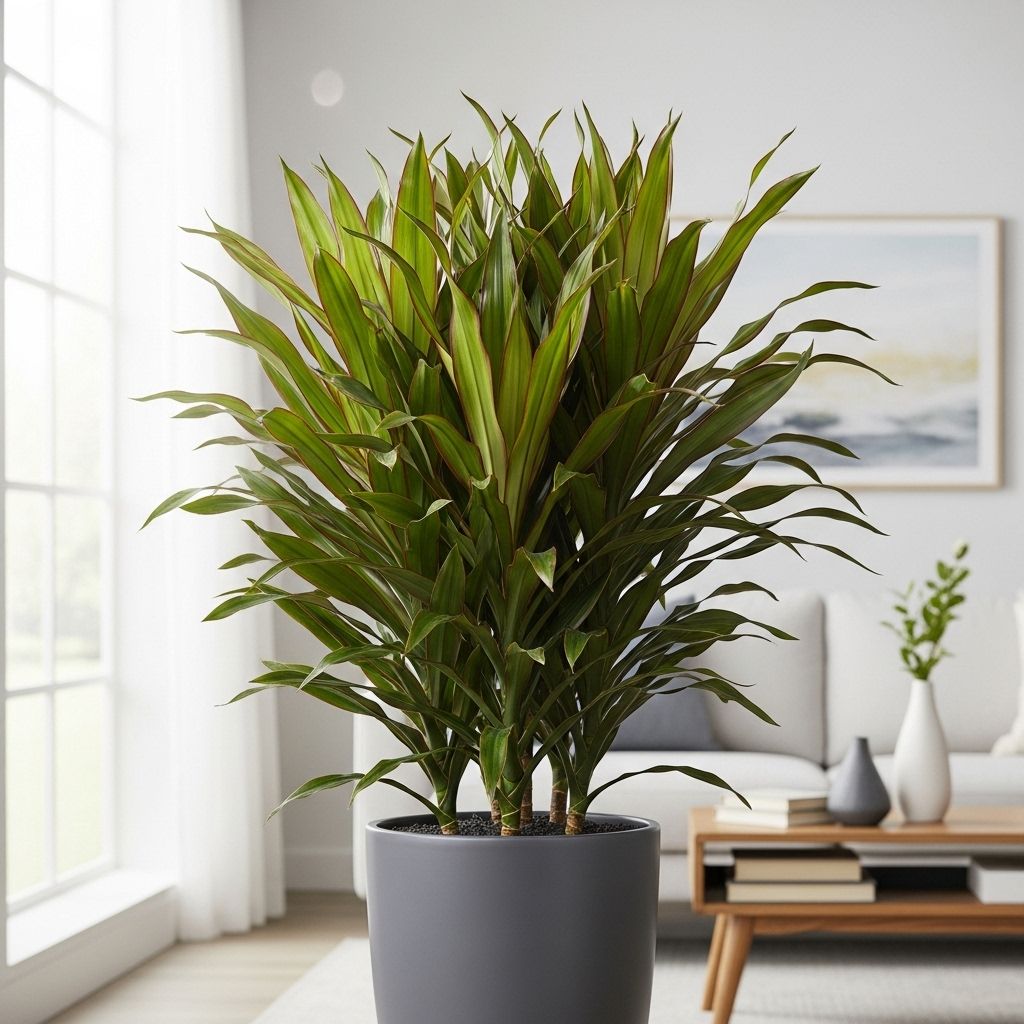Dracaena Plant Care: Expert Tips For Beautiful, Healthy Growth
Discover how to cultivate these versatile, air-purifying houseplants with minimal effort for maximum impact

Image: HearthJunction Design Team
Introduction to Dracaena Plants
Dracaena plants have earned their place as some of the most beloved houseplants worldwide, valued for their striking architectural form, variegated foliage, and remarkable adaptability to indoor conditions. With approximately 120 species in the Asparagaceae family, these plants—whose name derives from the ancient Greek word drakaina meaning “female dragon”—offer incredible diversity in size, color, and growing habits.
Native primarily to Africa, South Asia, Northern Australia, and Central America, dracaenas bring a tropical aesthetic to any indoor space. What makes them particularly appealing to both novice and experienced plant enthusiasts is their forgiving nature and longevity—with proper care, these plants can thrive for decades, some reaching impressive heights indoors while remaining relatively low-maintenance.
Beyond their aesthetic appeal, dracaenas have earned recognition from NASA for their air-purifying capabilities. These plants effectively filter indoor air pollutants such as formaldehyde, benzene, and trichloroethylene, making them not just beautiful additions to your home but functional ones as well.
Popular Dracaena Varieties
The dracaena genus offers remarkable diversity, with varieties suited to different spaces and aesthetic preferences. Here are some of the most sought-after types:
Dracaena Marginata (Dragon Tree)
Perhaps the most recognizable dracaena, the Dragon Tree features slender, arching leaves with red edges emerging from woody stems. This variety can reach up to 20 feet in its natural habitat but typically stays under 6 feet indoors. Its dramatic silhouette makes it perfect as a statement plant in modern interiors.
Dracaena Fragrans (Corn Plant)
The Corn Plant earned its common name from its resemblance to corn stalks. It features broad, glossy green leaves that cascade from thick, cane-like stems. Popular cultivars include ‘Massangeana’ with its yellow central stripe and ‘Lemon Lime’ with vibrant chartreuse foliage. These varieties excel in low-light environments.
Dracaena Reflexa (Song of India)
This variety is prized for its densely packed, narrow leaves with bold yellow or cream margins. More compact than other dracaenas, it works beautifully in smaller spaces and adds a bright accent to any room. Its bushy growth habit creates a full, lush appearance even when young.
Dracaena Deremensis Varieties
This group includes popular cultivars like ‘Janet Craig’ with its deep green, glossy leaves and ‘Warneckii’ featuring striking white striped foliage. These varieties tend to be particularly resilient to indoor conditions and are excellent choices for beginners.
Dracaena Sanderiana (Lucky Bamboo)
Though not true bamboo, this dracaena is often marketed as such and plays an important role in feng shui. It can be trained to grow in spirals or other decorative shapes and is frequently grown in water rather than soil.
Dracaena Plant Care Essentials
Light Requirements
Dracaenas are adaptable to various light conditions, but they thrive best in bright, indirect light. While they can tolerate lower light settings, their growth will slow, and variegated varieties may lose some of their distinctive coloration. Avoid placing dracaenas in direct sunlight, as this can scorch their leaves, causing brown spots and crispy edges.
East or west-facing windows often provide the ideal light balance for these plants. If using a south-facing window, position the plant several feet away from the glass or filter the light with a sheer curtain.
Watering Guidelines
One of the most common pitfalls in dracaena care is overwatering. These plants are drought-tolerant and prefer to dry out between waterings. A good rule of thumb is to wait until the top 50% of the soil is dry before watering again. When you do water, do so thoroughly until water drains from the bottom of the pot, then discard any excess water from the saucer.
Importantly, dracaenas are sensitive to fluoride and other chemicals commonly found in tap water, which can cause brown leaf tips. For best results, use distilled water, rainwater, or allow tap water to sit out overnight before using it on your plants.
Soil and Potting
Dracaenas prefer well-draining, slightly acidic soil. A quality houseplant potting mix amended with perlite or coarse sand will provide adequate drainage. These plants don’t require frequent repotting and actually prefer to be somewhat rootbound. Repot only every 2-3 years or when roots begin growing through drainage holes.
Choose a container with drainage holes that’s only 1-2 inches larger than the current pot to avoid excess soil that could retain too much moisture. Terracotta pots are excellent choices as they wick away excess moisture from the soil.
Temperature and Humidity
As tropical plants, dracaenas thrive in warm environments with temperatures consistently above 65°F (18°C). They will suffer damage if exposed to temperatures below 55°F (13°C), so keep them away from drafty windows and doors during winter months.
While they can adapt to average household humidity levels, dracaenas appreciate higher humidity. In dry environments or during winter heating season, consider using a humidifier nearby or placing the pot on a pebble tray with water.
Fertilizing Schedule
Dracaenas are light feeders and require minimal fertilization. During the growing season (spring and summer), apply a balanced liquid houseplant fertilizer diluted to half-strength once every 2-3 months. Avoid fertilizing in fall and winter when growth naturally slows. Over-fertilization can cause salt buildup in the soil and damage to the roots, so when in doubt, under-fertilize rather than over-fertilize.
Pruning and Maintenance
While dracaenas don’t require frequent pruning, occasional trimming helps maintain their shape and promotes bushier growth. You can safely cut back leggy stems or remove height if your plant is getting too tall. The best time to prune is during the active growing season in spring or summer.
To prune, use clean, sharp scissors or pruning shears and make cuts just above a leaf node. The plant will often branch from this point, creating a fuller appearance. You can remove up to one-third of the plant’s height without causing harm.
Regularly remove any yellowing or dead leaves by gently pulling them away from the stem or cutting them at the base. This not only keeps the plant looking its best but also prevents potential disease issues.
Dust accumulation on leaves can interfere with photosynthesis and make it harder for the plant to breathe. Wipe both sides of the leaves periodically with a damp cloth to keep them clean and allow for optimal air exchange.
Propagation Methods
Propagating dracaenas is relatively straightforward, making it easy to multiply your collection or share with friends. The most common propagation methods include:
Stem Cuttings
This is the most popular method for dracaena propagation. Simply cut an 8-inch section from the top of a healthy stem using clean, sharp pruners. Remove the lower leaves, leaving several at the top. You can then either:
- Place the cutting in a container of clean water, changing it weekly until roots develop (usually within 2-4 weeks), then transfer to soil
- Dip the cut end in rooting hormone and plant directly in moist potting mix, keeping the soil consistently damp until new growth appears
Air Layering
For larger specimens or when you want to create a new plant while reducing the height of an existing one:
- Make a small incision in the stem where you want roots to form
- Apply rooting hormone to the wound
- Wrap the area with damp sphagnum moss and cover with plastic wrap
- Once roots appear through the moss (usually in 4-8 weeks), cut below the rooted section and pot it up
Cane Sections
Even bare sections of dracaena canes can produce new plants:
- Cut a section of leafless cane into 2-3 inch segments
- Lay them horizontally in moist potting mix, partially buried
- Keep warm and moist until new shoots emerge from the nodes
Spring is the ideal time for propagation when the plant is entering its active growth phase.
Troubleshooting Common Problems
Brown Leaf Tips
This is perhaps the most common issue with dracaenas, typically caused by:
- Fluoride or chlorine in tap water
- Low humidity
- Salt buildup from over-fertilization
- Dry air from heating systems
Solution: Use filtered or distilled water, increase humidity, flush the soil occasionally to remove salt buildup, and keep plants away from heating vents.
Yellowing Leaves
Yellowing foliage often indicates:
- Overwatering or poor drainage
- Natural aging of lower leaves
- Insufficient light
Solution: Allow soil to dry between waterings, ensure proper drainage, and provide adequate indirect light. Remove individual yellow leaves as they appear.
Pest Issues
Dracaenas can occasionally suffer from:
- Spider mites (especially in dry conditions)
- Mealybugs
- Scale insects
Solution: Regularly inspect plants, especially the undersides of leaves. Treat infestations early with insecticidal soap, neem oil, or by wiping leaves with a diluted alcohol solution.
Decorating with Dracaenas
Dracaenas are versatile design elements that can enhance various interior styles:
As Focal Points
Larger varieties like Dracaena marginata and Dracaena fragrans make striking standalone specimens in living rooms, entryways, or as corner plants in bedrooms. Their vertical growth creates natural height that draws the eye upward, adding dimension to your space.
In Plant Groupings
Combine different dracaena varieties with other houseplants to create dynamic plant displays. Their architectural form pairs beautifully with trailing plants like pothos or philodendron, creating visual interest through contrasting growth habits.
For Small Spaces
Compact varieties like ‘Janet Craig Compacta’ or young Dracaena reflexa plants are perfect for desktops, shelves, or small apartments where space is limited but greenery is desired.
As Room Dividers
Taller dracaenas can function as natural room dividers in open-concept spaces, creating visual separation without blocking light or requiring permanent structures.
Consider the leaf coloration when decorating—varieties with bright variegation like ‘Lemon Lime’ or ‘Song of India’ add vibrant accents to neutral spaces, while solid green varieties create a calming, lush atmosphere.
Frequently Asked Questions
Are Dracaena plants toxic to pets?
Yes, dracaena plants are toxic to cats and dogs. They contain compounds that can cause vomiting, excessive salivation, and in some cases, dilated pupils in cats. Keep these plants out of reach of curious pets or consider pet-friendly alternatives if you have animals that tend to chew on plants.
Why are my Dracaena’s leaves drooping?
Drooping leaves usually indicate either underwatering or overwatering. Check the soil moisture—if it’s completely dry several inches down, the plant needs water. If the soil feels wet and the stems feel soft, you may be overwatering. Adjust accordingly and ensure proper drainage.
How fast do Dracaena plants grow?
Dracaenas are moderate growers indoors. Under ideal conditions, they typically add 2-3 inches of height annually, though growth rates vary by variety. Dracaena marginata tends to grow faster than compact varieties like ‘Janet Craig Compacta.’ Growth slows significantly in winter or in low light conditions.
Can I place my Dracaena outdoors?
Dracaenas can be moved outdoors during warm months in partial shade locations, but they cannot tolerate temperatures below 55°F (13°C). Acclimate them gradually to outdoor conditions to prevent shock, and bring them back inside before temperatures drop in the fall.
How do I know when to repot my Dracaena?
Repot your dracaena when you notice roots growing through drainage holes, the plant becoming top-heavy, or growth slowing despite proper care. These plants prefer to be somewhat rootbound, so repotting is typically only needed every 2-3 years, using a pot only 1-2 inches larger than the current one.
With their striking appearance, air-purifying benefits, and forgiving nature, dracaenas have rightfully earned their place as staples in the houseplant world. Whether you’re a beginner looking for a low-maintenance companion or an experienced plant collector seeking architectural interest, there’s likely a dracaena variety that’s perfect for your space and lifestyle.
References
- https://www.livelyroot.com/blogs/plant-care/dracaena-care-guide
- https://www.thespruce.com/dracaena-overview-care-1902754
- https://mrec.ifas.ufl.edu/foliage/folnotes/dracaena.htm
- https://houseplantresourcecenter.com/2022/06/most-popular-the-ultimate-guide-to-dracaena-marginata/
- https://www.proflowers.com/blog/dracaena-care
Read full bio of Anjali Sayee












